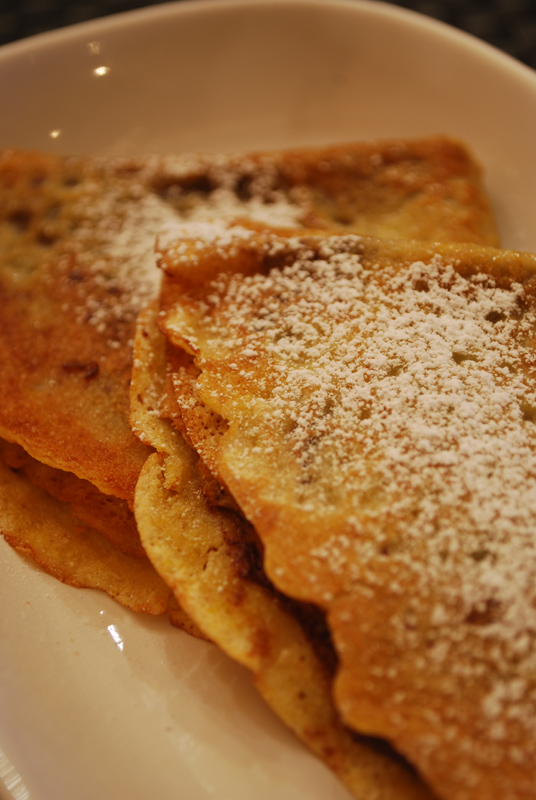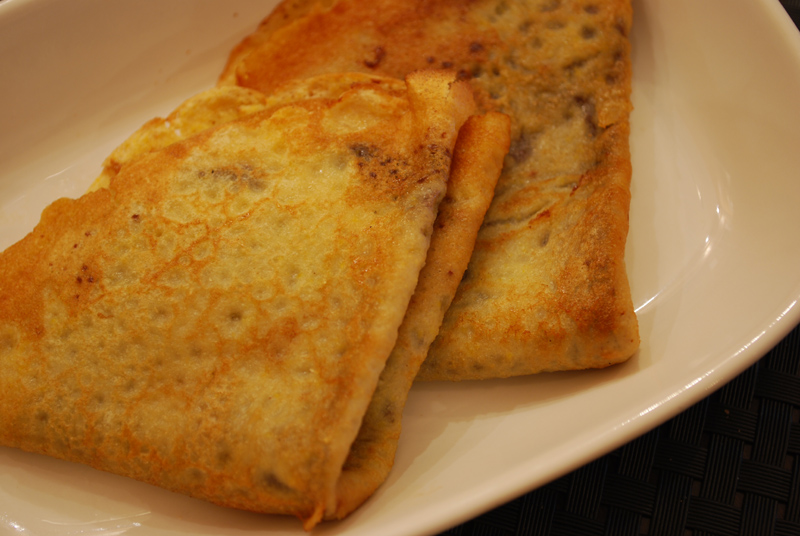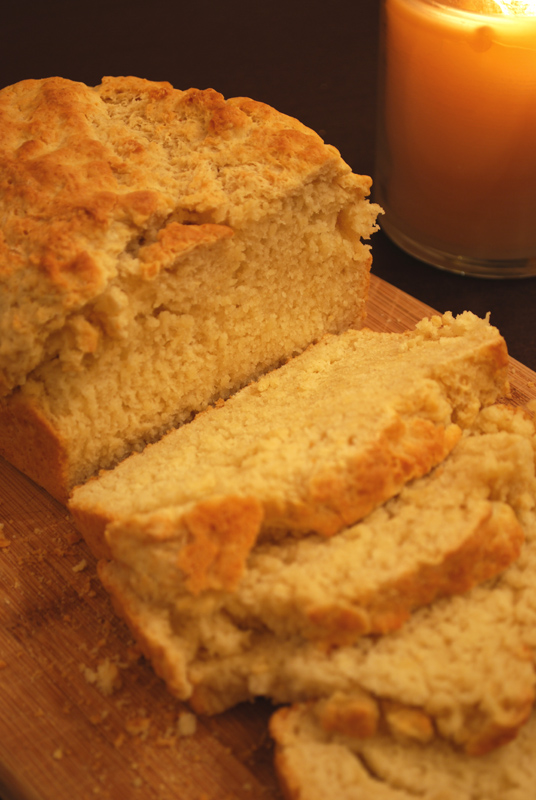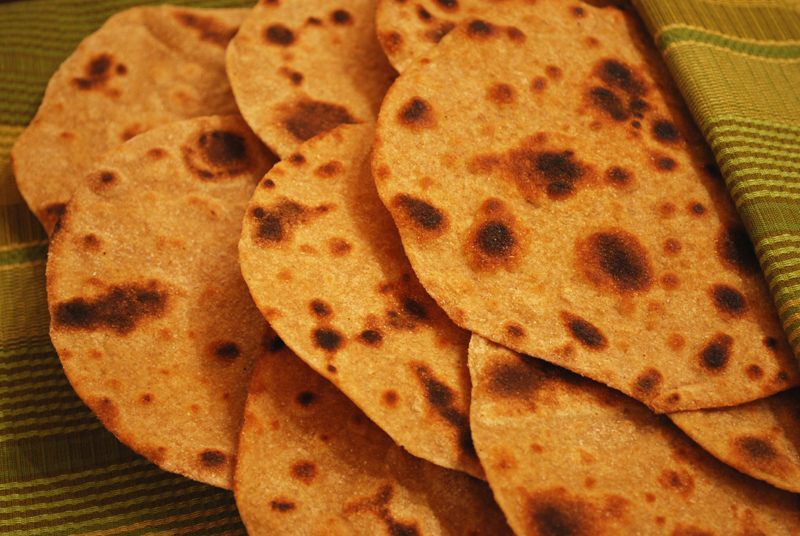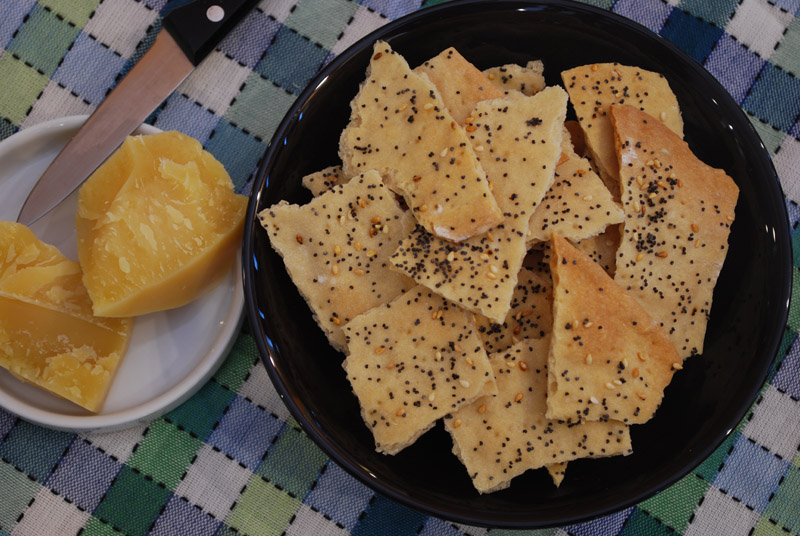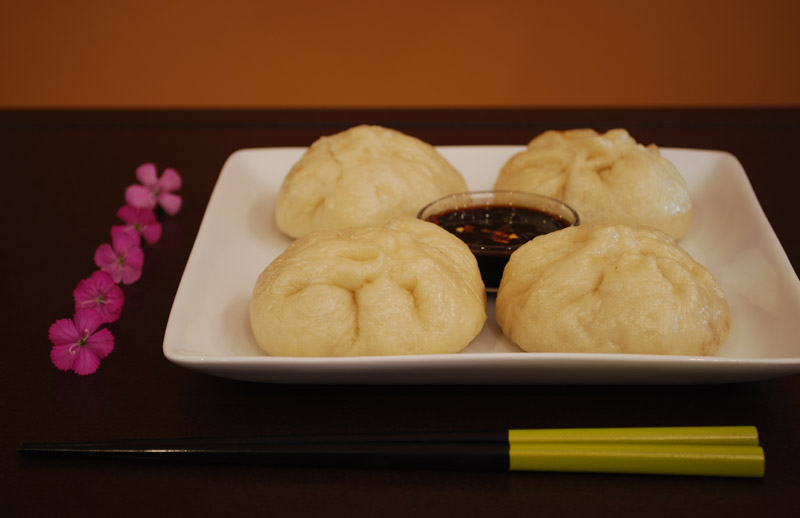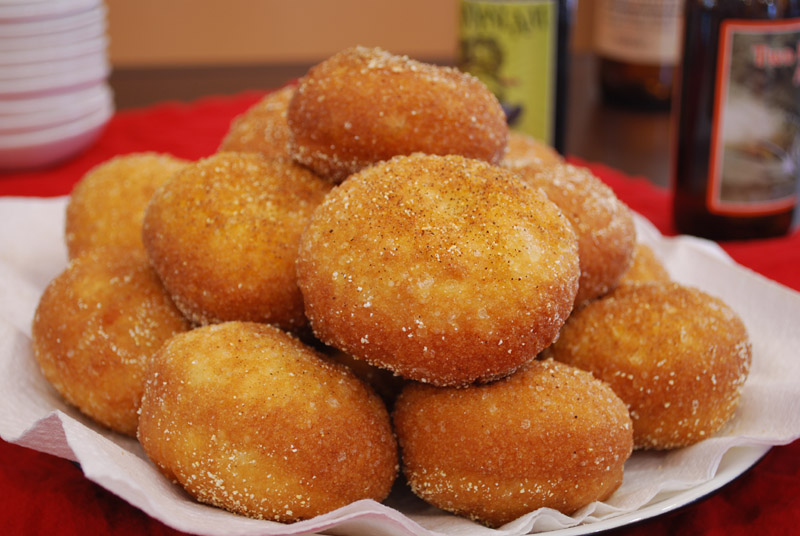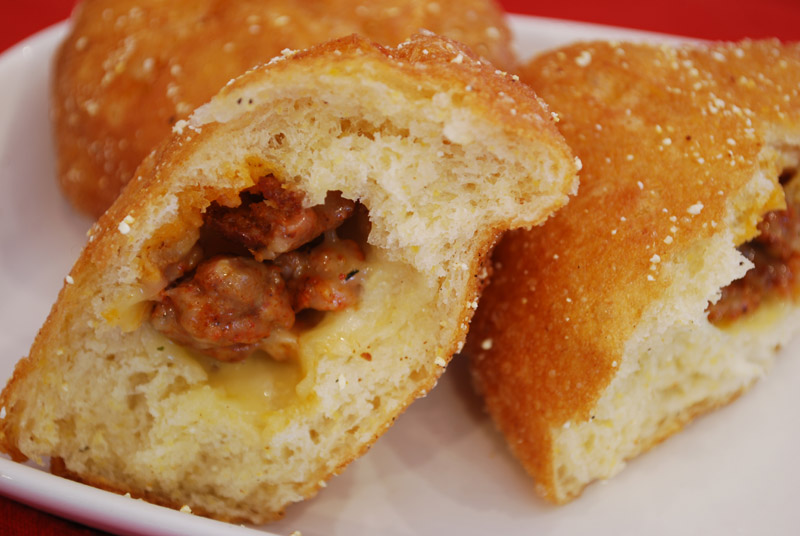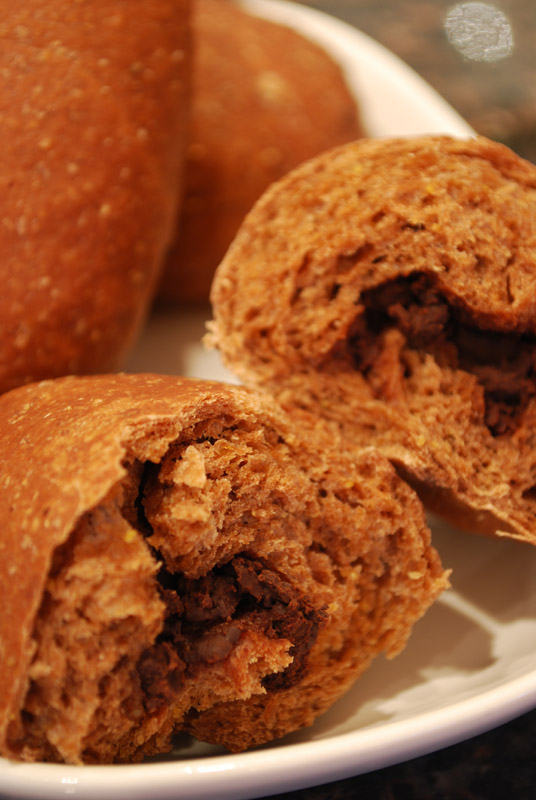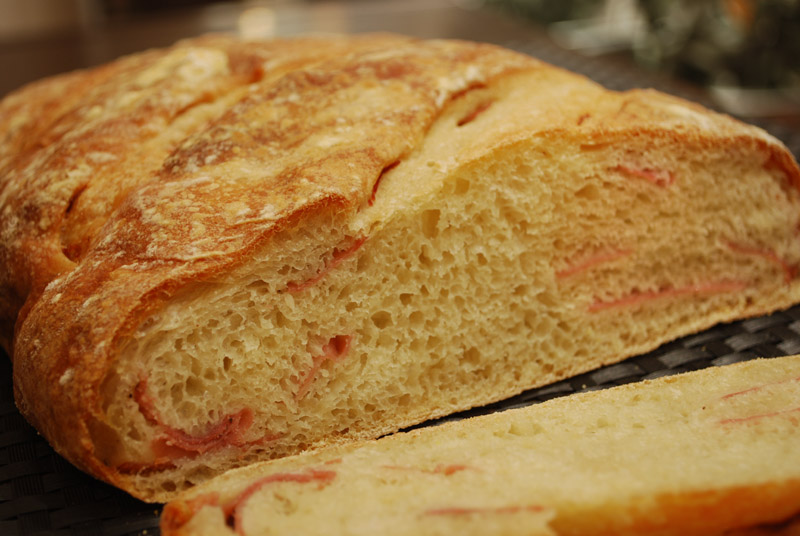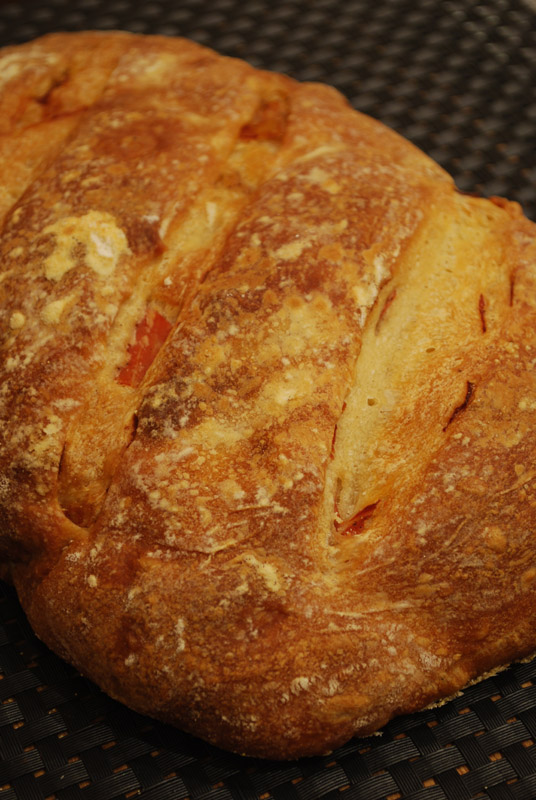Week Thirteen: Filled Breads
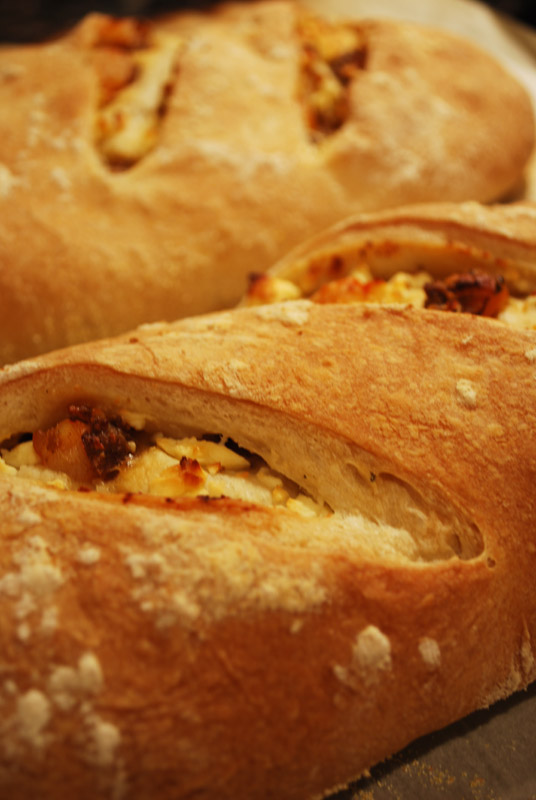
barbecue shrimp as bread
Well, it’s that time of year again. The days are suddenly longer, there’s the promise of warmth in the air, and trees and plants everywhere are starting to grow their leaves back. Yes, it’s Spring, and that means one thing: it’s almost time for Crawfish Bread!
See, in New Orleans, the beginning of Spring heralds the fast approach of JazzFest, those two glorious weekends in late April and early May when you can get an abundance of food you simply can’t get any other time of year. (Oh, and apparently there’s some fairly decent music, too.) I’m talking Crawfish Monica, Cochon de Lait po-boys, the mysteriously-named Oyster Sack, Mango Freezes, and the King of JazzFest fare, that fantastically good Crawfish Bread.
For those of you not in the know, Crawfish Bread involves some extremely good bread, filled with crawfish tails, spices, and apparently all of the cheese. It’s simple and a bit over the top, but tastes amazing. It’s so rich and so delicious, it’s probably a good thing they only serve it once a year. Like most Cajun and Creole food, you just know somebody’s been cooking all day to make it, and is thrilled to share it with you. Until they run out, that is, which they seem to do every year. If you’ve ever tried it, count yourself amongst the blessed.
So when I settled on filled breads this week, with Spring finally sprung, and JazzFest around the corner, it was a given that this native New Orleanian would make Crawfish Bread. But you see, I don’t live in New Orleans now. I live in Chicago. And most Chicagoans wouldn’t know which way on a crawfish was up, even if they had one, bless ’em. What I’m saying is that I couldn’t get my hands on any crawfish tails on short notice, and without great expense. A little improvisation was in order.
I had my heart set on something authentically New Orleanian, but I was relegated to ingredients available in Chicago. Shrimp are always readily available, but simply substituting shrimp for crawfish is like subbing water for chocolate. I racked my brain (and my cookbooks) for a similarly full-flavored and traditional shrimp dish, when I finally hit on it. Barbecue Shrimp! Perfect!
And once again, if you’re unfamiliar with New Orleans-style barbecue shrimp, allow me to enlighten you. Invented at the old-school Pascal’s Manale Restaurant, this dish contains no barbecue sauce, nor is it cooked on a grill. If you ever order it, be prepared for a plate full of shell-on and head-on shrimp, almost literally swimming in a butter-rich and extremely flavorful sauce, full of garlic, lemon, and spice. As for the name, you’re on your own. I don’t know, and I don’t think anyone else really does either. I think the origins have become more legend than truth anymore. Notwithstanding, it is easily worth the messy arms and dry-cleaning bill you end up with after indulging.
The problem with filling a bread with such a sauce-y dish is just that: the sauce. No way would it work. And where was the cheese? There had to be cheese! I then remembered a fantastic recipe from Melissa Kronenthal’s amazingly-written and -styled blog, The Traveler’s Lunchbox, which included shrimp, chiles, and feta. I’d never had such a combination that I can recall, and it was every bit as good as she makes it out. Feta it was, then. As for the sauce, I simply reduced the leftover liquid in the pot, and thickened it with a little flour.
So now, I had the seafood, a rich pop of full flavors from the reduced sauce, and the cheese. All that was left was to roll it into a batch of dough, and bake away. Now, I wasn’t about to just make some Barbecue Shrimp, and toss the lot into some dough. No, we ate nearly half of the shrimp for dinner, and had to stop ourselves eating more. As you can see below, I served it over brown rice (which is certainly not traditional at all, but helped round it out into an entrée), with crusty bread and beer (which is practically mandatory).
I know what you’re thinking, looking at the recipe below. You’re thinking there’s way too much seasoning. You’re thinking there’s way too much garlic. And you’re thinking there’s way too much butter. I know, because that’s what I thought at first; but then I decided to trust my source, the illustrious and venerable Commander’s Palace. Their cookbook has never, ever failed me; so I urge you to trust me in return. It may not be for the very faint of palate, but that combination of flavors is just delectably perfect! They know what they’re doing.
The aroma that filled the entire apartment was seductive and spicy, full of baking bread, rosemary, garlic, shrimp, and butter. It smelled like a Cajun kitchen ought to. I pulled the finished loaves from the oven, and little browned bits of shrimp and feta peered out at me through the slashes in the top like the bread was giving me a big snaggle-toothed grin. Was it a fair amount of prep work? Yes, it was. But was it worth it? Oh my, was it ever! Just you try it for yourself – you’ll see!
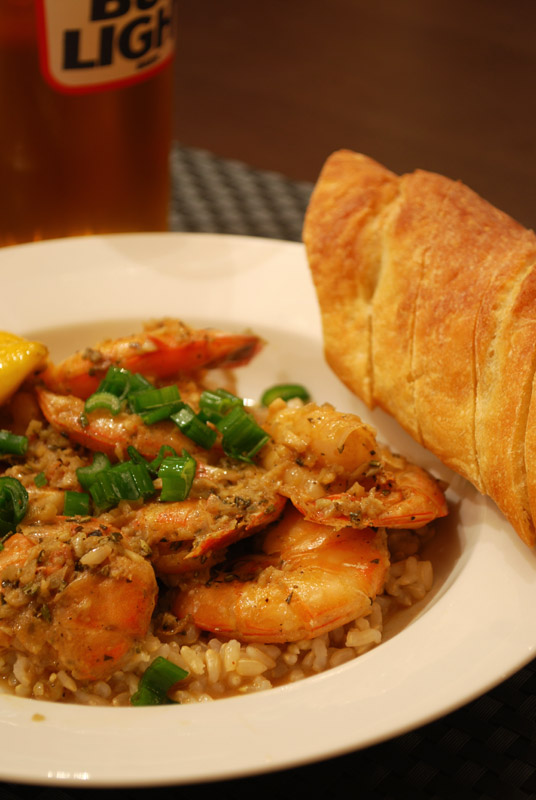
- barbecue shrimp as entrée
New Orleans-Style Barbecue Shrimp and Feta Bread
Adapted in part from Commander’s Kitchen, by Ti Adelaide Martin and Jamie Shannon
Makes 2 loaves
For bread dough:
2 1/4 teaspoons active-dry yeast
2 1/2 teaspoons sugar
2 tablespoons olive oil
1 1/4 cup warm water (105º-115º F)
17 1/2 ounces all-purpose flour (about 3 1/2 cups + 3 tablespoons)
1 teaspoon salt
For shrimp filling:
2 pounds large shrimp, shells on (preferably heads on, if you can find them)
2 tablespoons Creole or Cajun seasoning, divided
1 tablespoon olive oil
1 head garlic, peeled and minced
2 tablespoons chopped fresh rosemary
3 tablespoons Worcestershire sauce
3 tablespoons hot sauce
1 lemon, juiced, quartered (reserve juice and quartered rind)
1/3 cup beer
Salt and pepper to taste
1/3 cup minced parsley
4 tablespoons unsalted butter, room temperature
2-3 tablespoons all-purpose flour
6 ounces feta, crumbled
1. Make the dough: in the bowl of a stand mixer, combine the water and sugar, stirring until all the sugar is melted. Sprinkle the yeast over, and stir to dissolve. Let stand until foamy, about 5 minutes. Add the oil.
2. Reserving a handful of the flour, add the flour and salt to the mixture. Combine at low speed with the dough hook until dough comes together, adding the reserved flour by tablespoons only as needed. When dough no longer sticks to side of bowl, increase speed to medium and knead until a smooth, cohesive ball is formed. Stop the mixer and scrape the bowl and hook as necessary.
3. Transfer the dough to a lightly-oiled bowl, cover with plastic wrap, and let rise in a warm place for about 1 to 1 1/2 hours, or until doubled in size.
4. While the dough rises, cook the shrimp: lightly toss the shrimp with 1 tablespoon of the Creole seasoning. Preheat a large skillet or saucepan over high heat. Add the oil, and let it begin to smoke. Add the garlic and rosemary, and stir to lightly brown the garlic. Be careful not to burn it. Add the shrimp and stir. Add the Worcestershire, hot sauce, lemon juice, and quartered lemon rind. Let reduce slightly, 30 seconds to 1 minute.
5. Add the beer, and deglaze the pan by stirring and shaking the pan. Boil to reduce the mixture, and cook another 2 to 3 minutes until the shrimp are fully cooked (depending on size). The liquid should have a saucy consistency. Add the remaining tablespoon of Creole seasoning, pepper, salt, and parsley. Reduce the heat to medium-high and add the butter a little bit at a time, shaking the pan or stirring until incorporated. Adjust seasoning if needed, and remove lemon pieces.
6. Remove about 2/3 of the shrimp to a bowl to cool, leaving the sauce in the pan. (Eat the rest of the shrimp immediately, with a crusty baguette for soaking up the sauce, lemon wedges, and lots of paper towels; and enjoy!)
7. When cool enough to handle, peel the remaining shrimp and chop roughly, into about 3-4 pieces per shrimp. Reduce the remaining sauce in the pan by turning the heat to high, until thick and dark brown, but still a bit liquid. Turn the heat to medium-high. Add the flour by tablespoons, whisking to break up any lumps if necessary, and stir until a thick paste is formed. Cook an additional minute or two, stirring constantly. Turn off heat, and let cool in pan for a minute. Add to the chopped shrimp, and set aside.
8. Dust a baking sheet with cornmeal. Turn the dough onto a floured surface, and divide in half. Press each half into a rough circle, flour the top, and roll or press into an approximately 11 by 9 inch oval. Evenly sprinkle the tops of each with the feta (3 ounces per piece of dough), and the shrimp mixture, leaving a 1/2 to 1 inch border.
9. Starting with the longer side of the oval, carefully roll the dough up jelly-roll style, being careful not to let any filling escape. Pinch the seam gently to seal, tuck the loose ends under, and transfer to the prepared baking sheet, seam side down. Cover the loaves with plastic wrap and let rise at room temperature until doubled in size, about 1 1/4 hours.
10. Twenty minutes or so before baking, preheat the oven to 400º F. Remove the plastic wrap from the loaves, dust with flour, and make 3 quick, diagonal slashes in each loaf. Bake until the loaves are a rich brown color, about 30 to 35 minutes. Let cool slightly, before cutting and serving warm.
Notes:
1. I accidentally used bread flour instead of all-purpose, and it did come out a little tough. But otherwise, the flavor was spot on!
2. Again, please don’t adjust the garlic or other seasonings in the shrimp recipe (unless you have a very good reason, like a deathly allergy, or something). I know it seems like a lot, but just take a leap of faith with this one.

